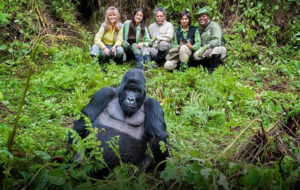Gorilla Trekking Rules in Rwanda – What to do, what is Expected and more Gorilla trekking Guide
Rwanda development board has both English and French speaking guides who will articulate guidelines and rules for gorilla trekking, hence visitors must report to the main visitor centre for briefing.
 A maximum of 8 people are allowed, sick visitors cannot see gorillas, a distance of 7 meters must be maintained while with gorillas, to limit human contact with gorillas viewing is limited for only one hour. Eating, drinking or smoking is prohibited as well as flash photography, whenever you feel like sneezing or coughing you must turn your head a way from gorillas and do so, littering by leaving papers or containers in the forest is not allowed. Plucking or destroying attractive flowers is not allowed. Visitors must stay in a tight group while watching gorillas because if gorillas charge and you are all together they also find it difficult to attack.
A maximum of 8 people are allowed, sick visitors cannot see gorillas, a distance of 7 meters must be maintained while with gorillas, to limit human contact with gorillas viewing is limited for only one hour. Eating, drinking or smoking is prohibited as well as flash photography, whenever you feel like sneezing or coughing you must turn your head a way from gorillas and do so, littering by leaving papers or containers in the forest is not allowed. Plucking or destroying attractive flowers is not allowed. Visitors must stay in a tight group while watching gorillas because if gorillas charge and you are all together they also find it difficult to attack.
When guides are done with briefing the next thing to is to get ready in a good hiking gear in preparation for the wet conditions in the rainforest. Sometimes trails are slippery and muddy which often time visitors find it tiresome hence you must be prepared to avoid getting stuck in the middle of the forest. Gorilla trekking may take 30 minutes or a full day depending on the location of gorillas.
What to pack and wear before tracking gorillas in Rwanda
Enough drinking water and packed meals which you can arrange with your lodge
Long sleeved pants, shirts, warm under wears to prevent coldness, gloves to grip vegetation as you slide on muddy trails, hut, insect repellents, rain jackets, and rain proof camera jackets, as well as camera equipment such as extra batteries, lenses and memory cards.
Walking sticks are also good to support your hiking.
All these are packed into a light backpack; visitors can hire porters at a cost of 10 USD to carry the bag and sometimes to give them a push or hold your arm to while crossing trenches and rivers.
Visitors led by guides make their way into the forest accompanied by armed rangers. The dense canopies teeming with enchanting calls of numerous species of birds, then voices must be low to increase chances of seeing other wildlife in the forest such as worth hogs, bush pigs, and primates like golden monkeys. Along the trails you can see orchids, tree ferns, flowers and climbing plants hanging over tree branches.
Trackers keep in constant communication with guides to determine the location of gorillas. you are not guaranteed to see gorillas you just have 95 % chances because gorillas move wherever they want and trackers closely follow their fresh droppings, chewed vegetation, or nests where they slept the previous day until they are found. Meanwhile guides usually make regular stops to gain energy and breath.
Finally a group is located and it’s time to watch gorillas feeding, playing, resting, female gorillas groom the young ones as they go by the side of a silverback as a protective sign. Switch off your flash and take many photographs as you want. Vegetation is more open due to bamboo hence a great chance to take clear pictures for the memories.
![]() While with gorillas do not make sudden movements, at times gorillas stay in closed thickets which can make viewing and photography difficult. Keeping a distance of 7 meters may be meaningless when playful baby gorillas come closer to visitors. Your guide will instruct you not to run or touch a gorillas just be calm, move backwards without using threatening body language. Remember gorillas are wild animals and are liable to charge or attack if provoked beyond normal.
While with gorillas do not make sudden movements, at times gorillas stay in closed thickets which can make viewing and photography difficult. Keeping a distance of 7 meters may be meaningless when playful baby gorillas come closer to visitors. Your guide will instruct you not to run or touch a gorillas just be calm, move backwards without using threatening body language. Remember gorillas are wild animals and are liable to charge or attack if provoked beyond normal.
Best time to visit Rwanda for gorilla tracking
Gorilla tracking is done all year round, but the tourists prefer the dry season between the months of June to September and December to February. This time the rains are not frequent but it does not mean there is no rain. Trekking gorillas becomes quite easier since trails are not that muddy and slippery. On the other hand the wet season usually begins in march – April with heavy rains and short rains between October and November. Visitors become few and it’s a good option to avoid the crowds and track gorillas in a rainy season. Gorillas also tend to be staying close to trekking point due to much food such as fruits, vegetation that makes them move for short distances.